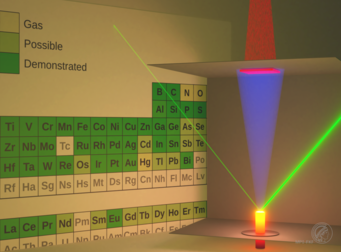Thermal Laser Evaporation of Elements From Across the Periodic Table

Simplified artistic representation of thermal laser epitaxy. A CW heating laser is incident upon a freestanding elemental source, heating it to temperatures where significant evaporation of the source occurs. This elemental vapor is then deposited onto a substrate heated by a laser.
Thin-film devices are becoming increasingly common in our everyday lives, with applications varying from touch screens to rechargeable batteries to thin solar cells. As further potential applications emerge, the demand for synthesizing highly pure thin-film compounds composed of vastly different constituents from across the periodic table is growing accordingly. At the same time, high-power lasers have become affordable and sufficiently practical in the past decade, meaning that vapors of many individual elemental sources can be generated for film growth. This has paved the way for thermal laser evaporation (TLE), a new method to grow thin films that utilizes continuous-wave laser heating and evaporation of individual freestanding elemental sources, see Fig.1.
Recently, as published in Journal of Laser Application 33, 022008, 2021 - Open Access, our team at the Max Planck Institute for Solid State Research has demonstrated the immense promise of TLE by showing that it can not only evaporate more than 40 elements from across the periodic table, it can also grow thin films for each element. By testing elements with different extreme growth parameters (including melting point, thermal conductivity and others), we found that TLE can be applied to any solid, non-radioactive element in the periodic table, allowing any feasible compound to be grown using elements having significantly different physical properties. For all the elements we tested, significant growth rates were achieved using less than 500\,W of output laser power, resulting in a total power requirement comparable to other film growth techniques.

Freestanding Si source (12.7mm in diameter and 4mm thick) during deposition. A liquid phase can clearly be seen on the surface of the source.
For many of these elements, significant deposition was possible from freestanding sources, eliminating the need for a crucible. For materials that melt at high temperatures, the solid--liquid boundary remained inside the source, essentially allowing for the source to act as its own crucible as shown in Fig.2. This effectively removes contaminants or any issues regarding the mismatch of thermal properties arising from the use of an external crucible. This highlights another major advantage of TLE: the growth of high-purity thin films without contamination from crucibles or heating elements.
In a nutshell,TLE constitutes a technologically simple method to synthesize high-purity thin films that exploits adsorption-controlled growth without the need for crucibles or complex chamber geometries. TLE shows immense promise for growing a wide variety of compounds ranging from semiconducting oxides to vast heterostructures with exotic electronic properties. Based on these notable results and the prospect of still more exciting developments to come, the future of TLE looks bright like a laser.

